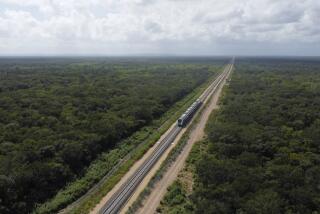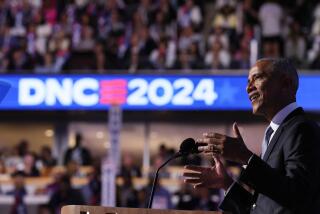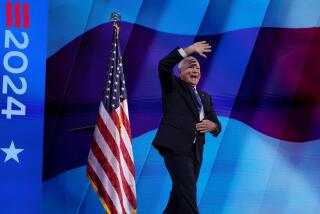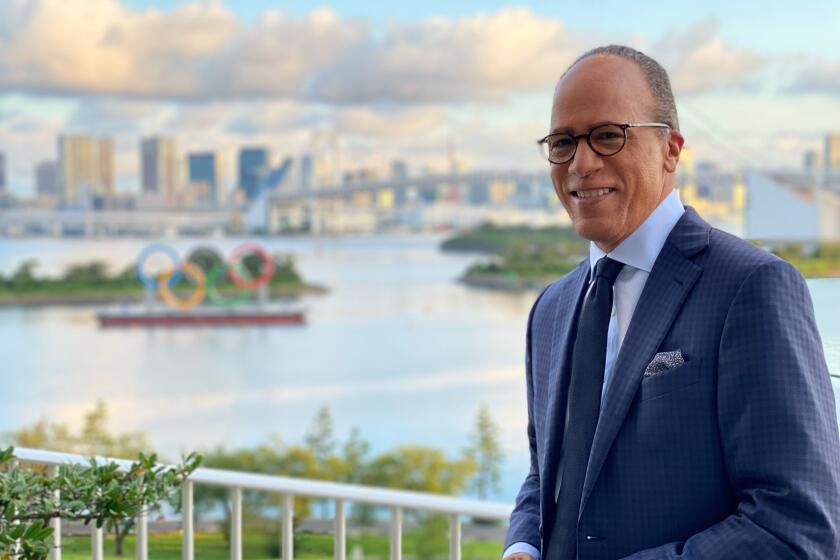Clinton Speech Is Still a Work in Progress
- Share via
KALAMAZOO, Mich. — Between speech-making and ropeline duty, President Clinton has been grinding away at his nomination acceptance speech with all the diligence of the A-student he once was. Well, maybe not all the diligence.
To the chagrin of his speech-writing team, the president has played a bit of hooky during his rail trip to Chicago, as he took time to mingle with admirers and hail onlookers from the rear platform of the train.
“He’s been working on his speech but not as religiously as some on the train would like--in part because I think he’s having too much fun seeing people along the way,” said Mike McCurry, the White House press secretary.
He did buckle down later Wednesday morning, scribbling longhand changes on a draft as the campaign train stopped in the Michigan cities of Battle Creek and Kalamazoo en route to its last stop in Michigan City, Ind.
The president has set aside a large block of time today to polish the speech at the Sheraton Hotel in Chicago, where he will be staying. And aides said that he may go to the convention center to take a look at the podium and TelePrompTer he will use.
Clinton actually has finished the text once or twice, said McCurry, “then he resurrects it and works on it some more.”
Clinton and the four members of the speech-writing team worked in a wood-paneled coach car that was just ahead of Clinton’s parlor car as well as in a work space farther forward on the train.
Unlike when he worked on some speeches earlier in his term, Clinton has not been calling a lot of friends and experts for ideas. Instead, he has used his new book, “Between Hope and History,” as a structure for the address.
That book itself is a compendium of themes, phrases, anecdotes and proposals that Clinton has collected since the 1994 midterm election. He started thinking about his acceptance speech last November, aides said. The speech-writing group buckled down to work about a month ago.
Helping with the speech have been domestic policy advisor Bruce Reed, speech writers Michael Waldman and Jonathan Prince and communications director Don Baer. But White House aides, trying to draw a contrast with GOP nominee Bob Dole, said that this speech belongs to Clinton rather than to his helpers.
One administration official said the speech could be accurately described as a sort of State of the Union II--an address bristling with policy proposals.
Clinton has been trying out some of the speech’s themes in his whistle-stop appearances on the four-day rail trip that delivered him to the convention. In town after town, he has declared that he now has the country on the right track after the economic slump of the early 1990s and can guide it toward prosperity and a better life for American families in the 21st century.
Clinton has drawn large crowds and an enthusiastic response in the 16 rallies on the excursion.
“Remember: 70 more days to four more years,” Clinton told a crowd at the red-brick Battle Creek, Mich., depot Thursday as the train began the final 125-mile leg through southwest Michigan and Indiana. At Battle Creek, more than 20,000 people waited until nearly 11:30 p.m. Tuesday to hear Clinton speak under a towering poplar tree.
The final stop was marred, however, when a 20-foot-speaker stand toppled into a crowd awaiting Clinton in Michigan City, injuring six.
The last day of the trip brought a final blast of new policy proposals for the second term. Clinton suggested five new environmental ideas, most of which would have little chance of success unless the Democrats gain strength in Congress.
They would cost $1.9 billion over four years. Most prominent among the five was a proposal to spend $1.3 billion to accelerate cleaning up the nation’s 1,387 polluted “Superfund” sites so that two-thirds would be restored to acceptable levels by the year 2000.
The other initiatives would seek to speed restoration of the polluted and unused industrial tracts called “brown fields;” allow the government to prosecute polluters for planning to pollute and freeze their assets during litigation; spend $196 million over four years to expand the information available to communities about local levels of pollutants, making it available on the Internet and other sources and spend another $76 million on grants to improve water quality.
The valuable campaign forum the 500-mile train trip provided Clinton did not come cheap.
The cost may be “way in excess” of $750,000, said McCurry. Of that, $113,000 will be paid by the Clinton campaign. News organizations, which sent 248 people on parts of the journey, will put up an estimated $250,000 of the total.
Officials defended the share picked up by taxpayers, saying that it reflects the ordinary high security costs of presidential travel in a dangerous age. The need for so much security is “an unfortunate fact of life in our country,” he said.
For better security, the Secret Service arranged for a lead train to travel ahead of the president’s, and a third locomotive to follow behind. One car of the principal train carried Secret Service agents. Another was filled with the gear of the White House communications office.
Clinton arrived in Chicago by helicopter after the rally in Michigan City, and went to the Sheraton Hotel where he watched the roll call of states and gave a thumbs up when the votes of the Ohio delegation clinched the nomination.
“It’s been a wonderful, wonderful trip,” a pumped-up Clinton said in brief remarks after his helicopter landed. The president, his voice going hoarse from four days of speechmaking, vetoed a late-night visit to the convention hall.
The last leg of Clinton’s journey was on a polished green-and-white Marine Corps helicopter that deposited him on the baseball field at the University of Illinois’ Chicago Circle campus. Thousands of well-wishers waved red, white and blue Clinton-Gore signs in greeting.
Clinton said he rode the train to look “into the eyes, into the faces and into the hearts of people who live in the heartland of America, the people I have worked with and fought for for the last four years. And I like what I saw.”
More to Read
Get the L.A. Times Politics newsletter
Deeply reported insights into legislation, politics and policy from Sacramento, Washington and beyond. In your inbox twice per week.
You may occasionally receive promotional content from the Los Angeles Times.








